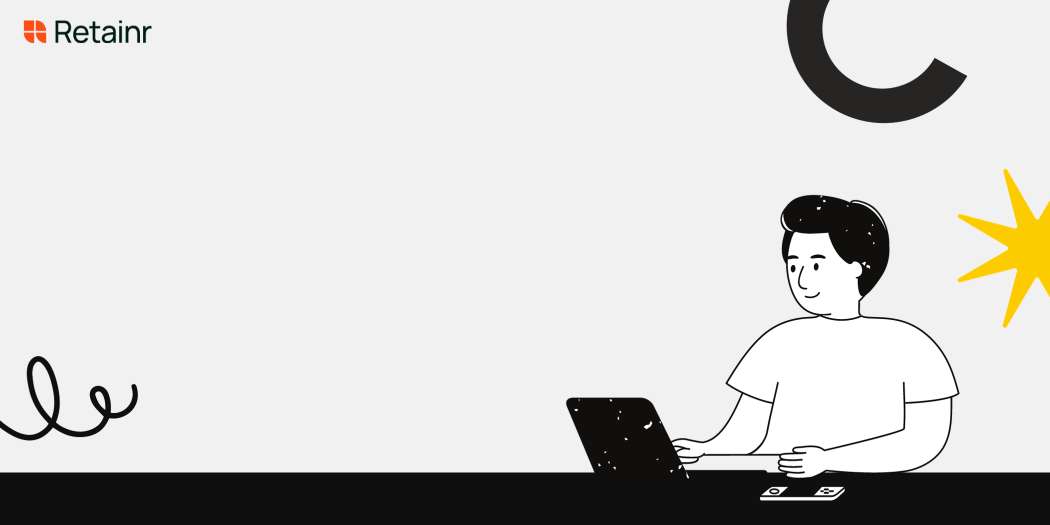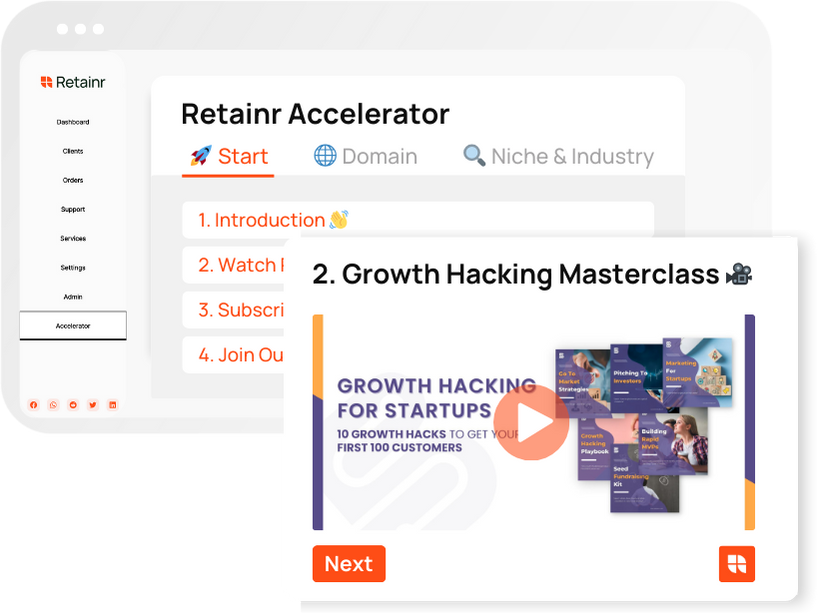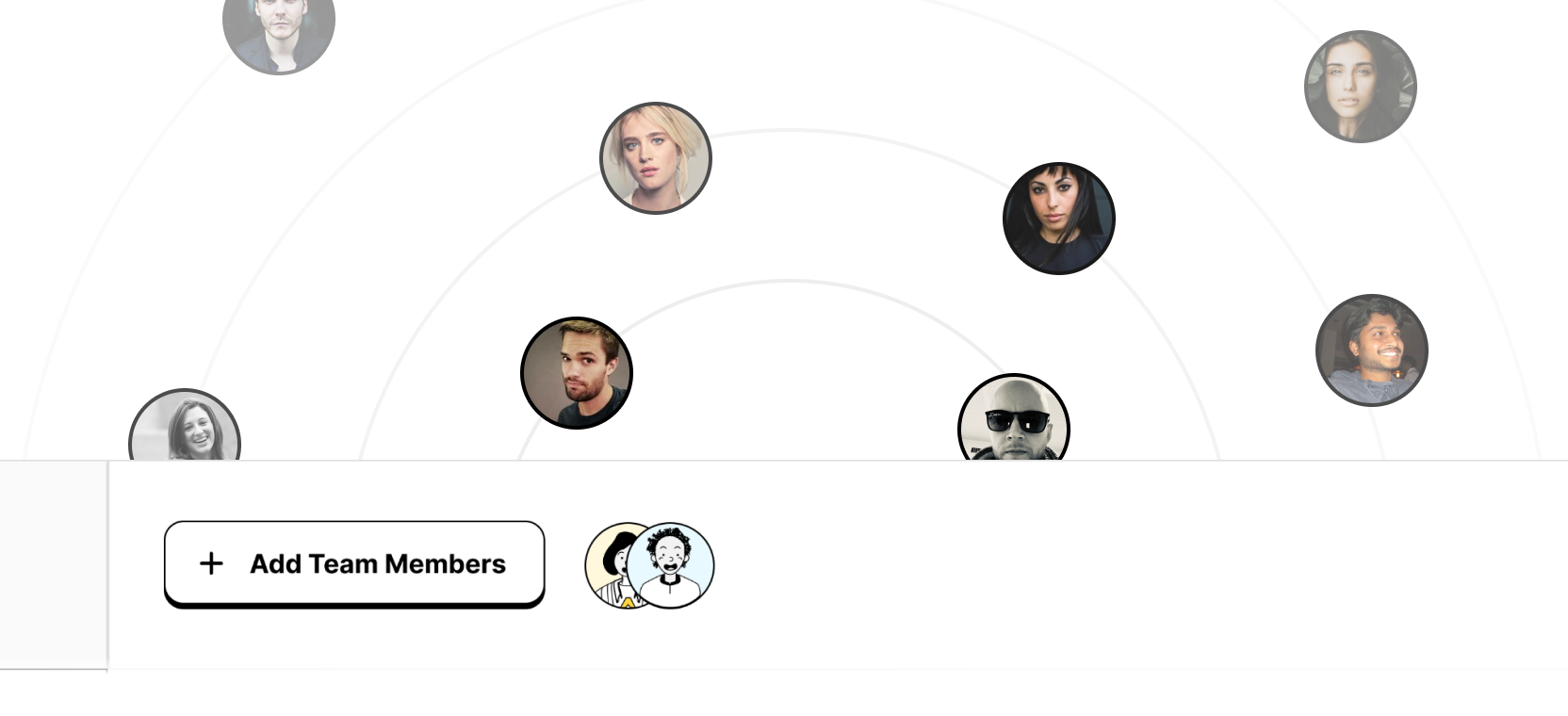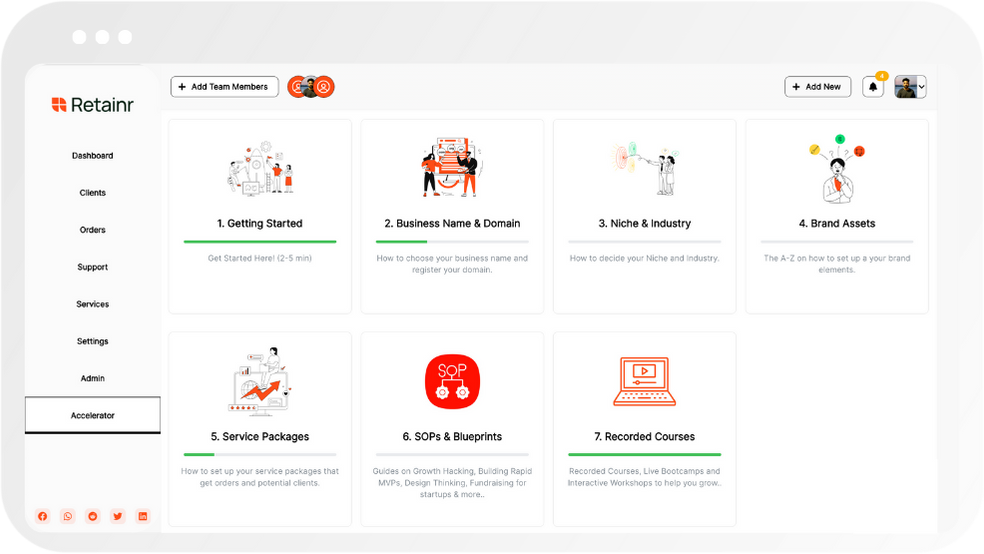
6 Tips and Tricks for Conducting Productive Client Workshops
Build with Retainr
Sell your products and services, manage clients, orders, payments, automate your client onboarding and management with your own branded web application.
Get Started1. What are the 6 tips and tricks for conducting productive client workshops?
Preparation for the workshop
Running an effective client workshop starts with diligent preparation. First, set clear objectives that outline what you intend to achieve by the end of the workshop. This helps you to guide the sessions effectively and stay on topic. Secondly, set an appropriate agenda with a logical flow to help your participants follow along. Lastly, take the time to understand your audience. What is their level of understanding of the subject matter? What are their expectations? This will help you align your content to their needs.
Execution of the workshop
When it comes to executing the workshop, being interactive is key. Use facilitation techniques to encourage participation from all members. This can include activities such as brainstorms and breakout sessions. Additionally, remember to create a safe space where every participant can freely share their thoughts and ideas. Lastly, be adaptable. Sometimes, you may need to adjust the pace or the content depending on the group dynamics. Be tuned into the needs of the participants. Also, equip the venue with the necessary tools and amenities needed for a successful session.
After the workshop
The work doesn't end when the workshop does. Ensuring the effectiveness of your workshop involves carrying out a follow-up process. This can include distributing workshop outputs to the participants, asking for feedback that can improve future workshops, and setting a time and date for a follow-up meeting if necessary. Below is a summary in table form:
| Stage | Action |
|---|---|
| Preparation | Set objectives, draw an agenda, understand the audience |
| Execution | Be interactive, create a safe space, adapt, equip the venue |
| After | Distribute outputs, ask for feedback, schedule a follow-up |
2. How can these tips increase the productivity of client workshops?
Increased Understanding and Collaboration
These tips can significantly enhance the productivity of client workshops by facilitating better understanding and collaboration. Through a well-planned agenda and the use of visual aids, clients get an easy grasp of your ideas, which in turn, prompts productive discussions. Similarly, by involving everyone and dividing the workshop into small sessions, participants can effectively share their thoughts and ideas. Here is a breakdown:
- Well-planned agenda: Guides the workshop, staying focused on relevant topics.
- Visual aids: Helps illustrate points more clearly, ensuring effective communication.
- Involving everyone: Fosters diverse perspectives, sparking creativity and innovation.
- Dividing into small sessions: Prevents information overload, aiding in better comprehension and participation.
Improved Time Management and Follow-up
Another set of these tips promotes efficient use of time and ensures follow-up, key for higher productivity. Setting time limits keeps the workshop from dragging and maintains participant interest. Meanwhile, providing clear action items makes it obvious what steps need to be taken after the workshop, preventing confusion and wasted time. Lastly, making the session interactive counteracts passive listening and keeps participants engaged throughout. These are summarized in the following table:
| Tip | Impact |
|---|---|
| Setting time limits | Prevents inertia, and keeps the session lively |
| Provide clear action items | Encourages follow-up, promoting accountability and efficient progress |
| Interactive Session | Fosters engagement, improving focus and absorption of information |
3. What is the importance of setting clear objectives before conducting client workshops?
The Significance of Purpose Setting Pre-Workshop
Setting clear objectives before conducting client workshops is crucial to ensure a focused and productive session. It offers numerous benefits such as defining the scope of the meeting, sharpening the overall focus, and dictating the flow of the entire event.
- Defining Workshop's Scope: Precise objectives help delineate what areas the workshop will cover. Without this, the session could potentially stray into unrelated topics. This can cause confusion and waste valuable time.
- Sharpening The Focus: When objectives are clear, it ensures that all stakeholders are aligned towards the same goal. This circumvents potential misunderstandings and gives the session a unified direction.
- Dictating the Flow: Lastly, objectives determine the structure and sequence of the workshop. The preset objectives set the groundwork for an agenda which prioritizes the most pertinent points.
Setting Workshop objectives
Deciding on clear and achievable objectives is a collaborative effort that involves both the workshop facilitator and the client. Using a SMART framework can make this process more effective. SMART is an acronym that stands for Specific, Measurable, Attainable, Relevant, and Time-bound. This enables the creation of both practical and purpose-driven workshop objectives.
Example of Workshop Objectives
| Specific | Identify potential improvement areas in the client's workflow system. |
| Measurable | Achieve a 20% increase in workflow efficiency. |
| Attainable | Introduce updated workflow software for more efficient management. |
| Relevant | Aligning the objectives with the long-term business goals of the client. |
| Time-bound | Implement solutions within the next 6 months. |
In conclusion, setting clear objectives before conducting client workshops provides direction and clarity to the attendees, promotes a focused discussion, and ensures that the event is productive and beneficial for all parties involved.
4. Can you provide some tips for getting all the clients involved in the workshop discussions?
Ensure Everyone's Participation
Creating an open and inclusive environment is crucial for getting all clients involved in workshop discussions. You can achieve this by setting ground rules that encourage everyone to contribute, facilitating discussions to ensure all voices are heard and using tools for generating ideas collaboratively. For actualizing these, you can:
- Set a positive and respectful tone at the beginning of the workshop, providing clear guidelines that everyone's ideas and opinions are valued.
- Assign roles to participants such as note taker, time keeper, or group spokesperson to make them feel integral to the process.
- Provide each participant with sticky notes or online collaboration tools to write down their ideas, allowing them to contribute without being outspoken.
Encourage Active Listening
Active listening is another important aspect of getting all clients involved. Reinforcing its importance will make sure everyone understands and respects the views of others. Techniques you can use to enhance active listening include:
- Ensure that only one person speaks at a time and discourage interruptions.
- Use a 'talking stick' or similar object – the person holding it has the floor and others should pay attention.
- Instill the habit of paraphrasing – after someone speaks, another participant puts what they said into their own words, confirming understanding and making the original speaker feel heard.
Implement Group Activities and Breakout Sessions
Group activities and breakout sessions are excellent strategies for overcoming reluctance to engage and ensuring each client's participation. Consider incorporating the following:
| Activity | Purpose |
|---|---|
| Brainstorming sessions | Solicit ideas and creativity. Everyone's inputs are welcome, fostering a sense of involvement. |
| Small group discussions | Allow all clients to speak up in a less intimidating setup. This also facilitates deeper conversations on subtopics. |
| Role plays | Encourage active participation and empathy by having clients step into the shoes of different stakeholders. |
5. How can creating a comfortable environment contribute to a more productive client workshop?
Creating a Comfortable Environment
Creating a comfortable environment at workshops can work wonders for promoting a productive and effective session. Not only does it help reduce possible stress or tension, but it also encourages more open communication and collaborative work.
- Ergonomic seating: It may seem like a trivial aspect, but uncomfortable chairs can cause physical strain and distract people from the core activity. Providing ergonomic seating options improves comfort and allows the clients to focus better on the workshop.
- Good lighting and ventilation: Well-lit and well-ventilated spaces can significantly influence attendees' mood and energy levels. They promote alertness and can help keep the workshop dynamic.
- Accessible amenities: Access to necessities like restrooms, drinking water, stationery, etc., will help participants feel at ease and avoid unnecessary distractions during the workshop.
Comfortable Environment and Productivity
Enhancing comfort goes beyond just physical aspects; It also includes creating psychological comfort for attendees. Feeling secure, valued, and being in a stress-free environment stimulates creativity, fosters better collaboration and increases overall productivity.
| Psychological comfort element | Impact on productivity |
| Open-minded atmosphere | Promotes brainstorming, idea-sharing, and efficient problem-solving |
| Positive reinforcement | Boosts confidence and engagement, driving individuals to contribute more |
| Respectful and inclusive interaction | Ensures everyone’s points of view are heard, leverages diversity for innovation |
How to create a comfortable environment?
Use effective communication before, during, and after the workshop to set a friendly and respectful tone. Ensure that expectations and goals of the workshop are clear, encourage participation, address queries, respect different viewpoints, and provide constructive feedback. A balanced and structured agenda will keep things on point and avoid rush or duress. Snacks, breaks, and refreshments also help create a relaxed and congenial atmosphere.
6. What is the role of breakout sessions in a productive client workshop?
Understanding Breakout Sessions
Breakout sessions are a vital part of any productive client workshop. They act as a sub-conference or meeting within the wider workshop, allowing smaller groups of attendees to dissect, discuss and delve into specific topics at length. The goal here is to encourage intimate discussions, gain insights, and boost engagement levels among workshop attendees. In essence, breakout sessions drive engagement, stimulate problem-solving, and foster bonding between clients.
Importance of Breakout Sessions
- Enhanced Interaction: Breakout sessions offer attendees a conducive environment for interaction and participation. They provide a platform where clients can express themselves more confidently, voicing their opinions, ideas, and feedback.
- Focused Discussions: These sessions are typically dedicated to specific issues or topics, leading to a focused and in-depth discussion. It can help gain better insights into a particular area, leading to a comprehensive understanding and solutions.
- Active Engagement: Since these sessions are more intimate, it leads to active participation and engagement. Clients tend to participate more actively as they are more comfortable in smaller, less formal settings.
Breakout Session vs Overall Workshop
| Aspects | Breakout Session | Overall Workshop |
|---|---|---|
| Number of participants | Fewer participants allow for more interaction | More participants, less one on one interaction |
| Topic focus | Specific topics are discussed in detail | Overview of several topics discussed |
| Level of interaction | Higher level of interaction among participants | Lower level of personalized interaction |
7. What are some effective methods for facilitating dialogue in client workshops?
Effective Methods for Facilitating Dialogue in Client Workshops
Creating an open and engaging environment is crucial for sparking effective dialogue in client workshops. Here are a few techniques that can be applied:
- Establishing ground rules: To ensure everyone gets a fair chance to contribute, it’s important to set some ground rules at the beginning of the session. These can include one person speaking at a time, vigilantly respecting others' views, and requesting clarification rather than making assumptions.
- Using open-ended questions: Questions that can’t be answered with a simple 'yes' or 'no' encourage more expansive responses. Instead of asking "Do you like this feature?", consider asking "What do you like/dislike about this feature?"
- Providing silent thinking time: Some people need a bit more time to process information and formulate their thoughts. Allowing for short, silence periods can facilitate a more thoughtful and inclusive dialogue.
The Role of the Facilitator
As a facilitator, you play a key role in guiding the conversation and pushing it forward. Here is what you can do:
| Role | Action |
|---|---|
| Moderator | Ensure everyone’s views are heard and that the conversation stays constructive and on topic. |
| Clarifier | Paraphrase complex points, ask for explanations, and make sure everyone is on the same page. |
| Summarizer | Periodically sum up what has been said to solidify understanding and to remember key points for later discussions. |
Using Interactive Activities to Stimulate Dialogue
Interactive activities can be a valuable tool to break the ice and encourage fruitful discussions. Here are a few ideas:
- Brainstorming session: It provides clients with an opportunity to express their ideas freely without the influence of others' opinion.
- Group exercises: By splitting clients into smaller teams for specific tasks, you can stimulate dialogue, collaboration, and foster a sense of camaraderie.
- Role-playing: This activity allows clients to step into users' shoes and hence encourage empathy and understanding.
8. How does the follow-up process contribute to the success of a client workshop?
The Significance of Follow-Up Process Post Client Workshops
The follow-up process significantly contributes to the success of a client workshop in several ways. It's an effective way of reinforcing the trust and engagement initiated during the workshop and achieving better long-term outcomes. Here are three key reasons why this process is vital:
- Reinforces Learning: A follow-up can help reinforce the information learned during the workshop. This could include sending out a summary of the workshop, discussion points, or additional resources that add value to the attendees' learning experience.
- Feedback Collection: Follow-ups provide an excellent opportunity to collect feedback. Knowing how participants felt about different aspects of the workshop can help you improve future ones.
- Building Long-Term Relationships: Lastly, regular follow-ups help keep your brand or company on top of the client's mind, fostering long-term relationships and potentially leading to more opportunities.
A Follow-Up Strategy Post Client Workshops
In order to ensure a smooth and effective follow-up process, it's important to have a well-defined strategy that encompasses different stages and elements as depicted in the following table:
| Stages | Actions |
|---|---|
| Immediate Follow-Up | Send out a thank you email right after the workshop, expressing gratitude for their participation. |
| Post Workshop Summary | Within a week, share a comprehensive summary of the workshop and other key learnings or resources. |
| Feedback Collection | Set up a survey to gather participant feedback and learn about the areas of improvement. |
| Regular Updates | Keep the attendees engaged by sharing updates relevant to the workshop topic or your business. |
Tools for Effective Follow-Ups
With the evolution of technology, several tools aid in streamlining the follow-up process. These range from customer relationship management (CRM) systems to email marketing software and survey platforms:
- CRM Systems: Tools like Salesforce or HubSpot are excellent for keeping track of clients and scheduling follow-up activities.
- Email Marketing Software: Automation tools such as Mailchimp or Constant Contact can be used to send out bulk emails, ensuring efficient post-workshop communication.
- Survey Platforms: Use online survey tools like SurveyMonkey or Google Forms to easily collect and analyze participant feedback.
9. How much time should be allocated for breaks during a client workshop?
Considering Break Duration in Client Workshops
Planning for breaks during a client workshop is as crucial as designing the main content. Breaks facilitate better learning and interaction, allowing participants to relax, digest the information obtained, and reenergize for the following sessions. The duration and frequency of breaks can directly impact the productivity and effectiveness of the workshop.
Your workshop's timing, nature, and agenda will guide how much time should be allocated for breaks. Here's a guide:
- If the workshop lasts for 2 hours or less, a break may not be essential. However, a 5-10 minute break in the middle could be considered.
- For workshops that run between 2-4 hours, plan for a 15-minute break roughly in the middle of the session.
- Full-day workshops (about 5-8 hours) should ideally include two 15-minute breaks (morning and afternoon) and an hour-long lunch break.
Organizing Breaks During Workshop
Organizing your breaks effectively can maintain the momentum of your workshop and keep your participants revitalized. You can follow this general table guideline:
| Time Duration | Break Duration | Suggested Start Time |
|---|---|---|
| 2 hours or less | N/A or 5-10 minutes | Middle of the session |
| Between 2-4 hours | 15 minutes | Middle of the session |
| Around 5-8 hours | Two 15-minute breaks and 1 hour for lunch | Mid-morning, lunch, and mid-afternoon |
Whenever possible, try to maintain consistent times for breaks each day if the workshop lasts multiple days. This provides predictability for the participants and aids in managing and planning the day.
10. What are some recommendations for integrating interactive elements in a client workshop?
Integrating Interactive Elements
Interactive elements keep the participants engaged and make the learning process more effective. Some recommendations for integrating them in your client workshops include:
- Games and Quizzes: These can be designed around the product or service that your clients use. They encourage participation while adding a fun element to the workshop.
- Interactive Presentations: Rather than a static slideshow, consider using tools that allow participants to interact with the presentation. This could be through clickable areas, drag and drop activities, or integrated polls.
- Live Demonstrations: If applicable, have a live demonstration of the product. This is a hands-on way for your clients to understand its functionality.
The best kinds of interactive elements are those that promote collaboration among the participants. Following is a table illustrating some examples of interactive activities and their potential impact:
| Interactive Activities | Potential Impact |
|---|---|
| Group Discussions | Fosters exchange of ideas, increases comprehension |
| Q&A Sessions | Directly addresses concerns or queries, ensures understanding |
| Hands-on Demonstrations | Provides practical experiences, enhances engagement |
To optimally include these elements in the workshop, it’s crucial to ensure the activities are related to the clients’ needs. Plan the timing well, considering the workshop duration to avoid overloading attendees. Remember to provide clear instructions and always have a follow-up discussion or a summary to wrap up the learning points.
Conclusion
Ensure Clear Communication
To have a productive client workshop, make sure communication is clear, concise, and easy to understand. Avoid using technical jargon and ensure that all instructions are straightforward.Preparation is Key
Take adequate time to prepare for the workshop. Understand your client's needs, and customize the workshop content to cater to them. Also, prepare a detailed agenda to provide guidance throughout the session.Interactive Activities
Engage participants through interactive activities, discussions, and brainstorming sessions. This promotes creativity and motivates individuals to contribute their ideas.Manage Time Efficiently
Effective time management is critical. Allocate specific time for each section of the workshop and stick to this schedule. This ensures that all important topics are covered.Follow Up
After the workshop, follow up with the participants. Send out a summary of the workshop's key points, and ask for feedback to help you improve subsequent workshops.Utilize the Right Tools
Successful workshops are more likely when you use efficient tools. One such tool that can dramatically boost productivity is Retainr.io. This whitelabel software provides a streamlined solution for selling, managing client interactions, orders, and payments all through your own branded app.By implementing these tips and choosing the right tools like Retainr.io, you can effectively enhance the productivity of your client workshops and achieve your business goals.Boost Your Agency Growth
with Retainr Accelerator
Uncover secrets, strategies, and exclusive blueprints to take your agency's growth to the next level — from marketing insights to effective presentations and leveraging technology.

SOPs, Cheatsheets & Blueprints
Leverage 50+ SOPs (valued over $10K) offering practical guides, scripts, tools, hacks, templates, and cheat sheets to fast-track your startup's growth.
Connect with fellow entrepreneurs, share experiences, and get expert insights within our exclusive Facebook community.
.jpg)

Join a thriving community of growth hackers. Network, collaborate, and learn from like-minded entrepreneurs on a lifelong journey to success.

Gain expertise with recorded Courses, Live Bootcamps and interactive Workshops on topics like growth hacking, copywriting, no-code funnel building, performance marketing and more, taught by seasoned coaches & industry experts.

.jpg)

.jpeg)


